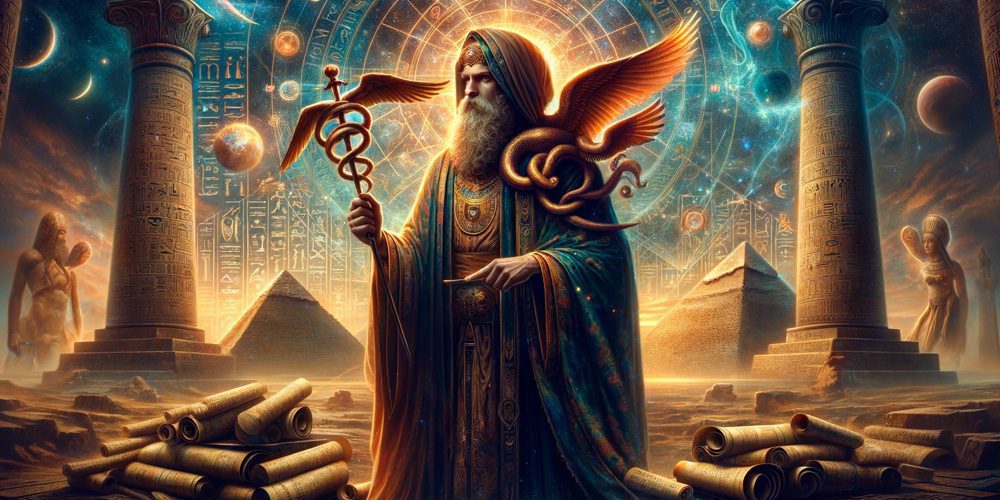In a world where noise and chaos often drown out tranquility, it’s worth taking a step back, an inward retreat of sorts, to explore the profound teachings of Hermeticism. This ancient branch of philosophical and spiritual thought is far from abstruse esoteric mumbo-jumbo.
Vielmehr handelt es sich um eine zeitlose Weisheit, die praktische Einblicke in die Geheimnisse der Existenz bietet. Die Hermetik schwebt in dem einzigartigen Raum, in dem Philosophie, Religion, Spiritualität und Wissenschaft zusammenfließen.
It isn’t confined by rigid dogmas but rather encourages a relentless pursuit of self-knowledge and universal understanding. It’s about achieving balance—of body, mind, spirit—and realizing our inherent unity with all creation.
Die Lehren der Hermetik sind voll von Paradoxien, die unsere konditionierten Wahrnehmungen herausfordern und uns dazu bringen, über unsere Komfortzone hinaus zu denken. Ein solches Beispiel ist: "Das Universum ist mental - gehalten im Geist des Alls". Dies legt nahe, dass alles, was wir als Realität wahrnehmen, aus Gedanken entsteht - ein ziemlich verblüffendes Konzept!
Im Kern lädt die Hermetik die Suchenden dazu ein, ihre emotionalen Zustände zu überwinden, indem sie sich ihre geistigen Fähigkeiten zunutze machen - ein vielversprechendes Angebot für alle, die in dieser turbulenten Welt Gleichmut suchen. Worauf warten Sie also noch?
Ready to dip your toe into these mystical waters? Let’s journey together down this rabbit hole…
Hermes Trismegistus: Der himmlische Schreiber
Fest verankert zwischen Mythos und Geschichte ist Hermes Trismegistus ("der dreimal so große Hermes"), von dem einige Gelehrte glauben, er sei eine Verschmelzung des griechischen Gottes Hermes und des ägyptischen Gottes Thoth. Diese illustre Gestalt wird oft mit einer Smaragdtafel in der Hand dargestellt, auf der kryptische Symbole und heilige Weisheiten stehen. Der rätselhafte Hermes Trismegistus gilt als Stammvater der hermetischen Lehren und als Schutzherr der Alchemie, Astrologie und anderer esoterischer Wissenschaften.
Seine Mischung aus griechischer Philosophie und ägyptischer Mystik soll eine breite Palette von Wissenschaften, Mathematik, Religion und sogar frühe Formen der Psychologie beeinflusst haben. Obwohl die historischen Beweise für seine Existenz bestenfalls lückenhaft sind, wirken seine Philosophien über die Jahrtausende hinweg weiter.
The Corpus Hermeticum—a collection of dialogues attributed to Hermes—has had a profound influence on Western mystical thought. Interestingly, Hermes isn’t just a figure frozen in time; he has been reinterpreted in various cultures over centuries—sometimes as a god or demigod, sometimes as a wise human sage.
Regardless of how he’s depicted or what name he’s given, his wisdom endures as timeless truths about life and existence. The study of Hermes Trismegistus provides an enriching framework for understanding not just hermetic principles but also the shared philosophical undercurrents across various ancient civilizations.
Decoding Existence: Understanding the Philosophy & Principles
Hermetic teachings are like a cosmic blueprint that guides us in exploring our innate potential while encouraging us to live harmoniously within the larger tapestry that is Life. It offers tools for achieving inner tranquility amidst external turmoil—a vision that many spiritual traditions share. The crux of Hermeticism lies in its seven principles stated in “The Kybalion,” considered by many as a cornerstone text offering succinct yet profound insights into life’s intricate maze.
These principles aren’t prescriptions but descriptions—pointers toward deeper truths behind apparent realities. The first principle—the Principle of Mentalism—posits that all is Mind; the universe is mental.
It’s a bold assertion that reality isn’t just a product of chemical reactions or physical laws, but of thought itself. In essence, it suggests we participate in shaping our realities through our thoughts.
Als Nächstes kommt das Prinzip der Korrespondenz - "Wie oben, so unten; wie innen, so außen". Es drückt die tiefe Verbundenheit zwischen allen Dingen und Ebenen der Existenz aus. Wenn Sie die Muster auf einer Ebene verstehen (z. B. Ihre subjektiven Erfahrungen), können Sie potenziell das Verständnis auf einer anderen Ebene erschließen (z. B. den Kosmos).
The remaining principles—Vibration, Polarity, Rhythm, Cause and Effect, and Gender—each offer unique perspectives on life’s dynamics. As we delve deeper into them in later sections, prepare to be amazed by their depth and universal applicability!
Tiefer in die hermetischen Prinzipien eindringen
Our adventure into the heart of hermeticism is about to get a tad bit more intense, dear reader. Let’s take a plunge into the mighty ocean of Hermetic Principles – they’re not just part of some arbitrary list. They are the commandments that govern the universe, according to Hermes Trismegistus himself!
Diese sieben Prinzipien sind keine geheimnisvolle Weisheit aus einem uralten Buch, sondern können hier und jetzt in unserem täglichen Leben angewendet werden. Sind Sie also bereit, diese tiefgründigen Geheimnisse zu entschlüsseln?
Buckle up! It’s time to dive deep beyond the surface and explore how these principles could help us see our world and ourselves from an entirely new perspective.
Und wer weiß? Vielleicht finden Sie am Ende mehr Fragen als Antworten.
But fear not! Isn’t that what any journey of discovery is all about?
Treat this section as your personal roadmap through hermetic philosophy – but remember, you’re in charge of your own interpretation. So without further ado, let’s delve right in.
Mentalism – It’s All in Your Mind, Literally!
Wir beginnen unsere kosmische Reise mit Mentalismus - hier dreht sich alles um Geist und Materie! Nach der Hermetik ist alles um uns herum mental; das Universum selbst ist Geist. Das bedeutet, dass alle sichtbaren und unsichtbaren Dinge ihren Ursprung in den Gedanken oder im Geist haben - was bedeutet, dass dein Geist immense Macht über deine Realität hat.
Natürlich geht es um viel mehr als nur darum, sich einen Cheeseburger vorzustellen und ihn vor sich zu sehen - wir sprechen hier von grundlegenden Veränderungen in der Wahrnehmung und im Bewusstsein. Das Konzept des Mentaluniversums mag sich auf den ersten Blick ein wenig schwindelerregend anfühlen (Wortspiel durchaus beabsichtigt), aber denken Sie daran, dass alles, was wir wahrnehmen, von unserem mentalen Zustand beeinflusst wird.
Schließlich ist die Wahrnehmung die Realität. Also, wagen Sie es, groß und kühn zu träumen!
Die Hermetik besagt, dass das, was Sie denken und glauben, die Welt um Sie herum prägt. Bevor Sie sich über diese Idee lustig machen, nehmen Sie sich einen Moment Zeit: Haben Sie schon einmal bemerkt, wie negative Gedanken negative Ergebnisse hervorbringen?
Korrespondenz - Wie oben, so unten; wie innen, so außen
Lassen wir den Mentalismus hinter uns und begrüßen wir die Korrespondenz - oder wie wir sie gerne nennen: Das Prinzip der kosmischen Symmetrie. Dieses Prinzip dreht sich um die Vorstellung, dass es immer eine Entsprechung oder Ähnlichkeit zwischen den Gesetzen der Phänomene auf den verschiedenen Ebenen des Seins gibt. Im Grunde genommen interagieren und korrespondieren alle Ebenen (physische, mentale oder spirituelle) miteinander.
Wie innen so außen; wie unten so oben - dieser Satz verkörpert das Konzept der Korrespondenz sehr schön. Alles, was in uns geschieht, spiegelt sich im Außen wider und umgekehrt.
Es ist wie eine unendliche Anzahl von Spiegeln, die sich gegenseitig reflektieren. Die Schönheit des Verständnisses dieses Prinzips liegt in der Erkenntnis, dass Veränderung von jedem Punkt aus erfolgen kann, sei es "oben" (die geistige Ebene), "unten" (die physische Ebene), von "innen" (die innere Welt) oder "außen" (unsere äußere Realität).
Vibration - Spürt die Frequenz, Leute!
Vibration – it’s not just about your phone notifications anymore! In hermetic philosophy vibration holds a lot more importance than alerting us about a new email – it’s what makes up our very existence.
Dieses Prinzip besagt, dass alles in ständiger Bewegung ist, nichts ruht und alles in verschiedenen Frequenzen schwingt - auch Sie! Ja, in der Tat, lieber Leser: Ihr Körper hat seine eigene, einzigartige Schwingungssignatur. Cool, oder?
So what’s the deal with everything buzzing? Well, we can use this principle to our advantage!
Indem wir unsere Schwingung erhöhen und uns auf höhere Frequenzen ausrichten, können wir Positives und bessere Chancen anziehen. Denken Sie daran: Gleiches zieht Gleiches an.
So if you set your frequency tuner on ‘Happiness’, you’re more likely to attract joyous experiences. Now that’s some sweet science!
Polarity – Life’s Not Just Black and White
Der nächste Punkt auf unserer magischen, geheimnisvollen Tour der hermetischen Prinzipien ist die Polarität - und nein, es geht nicht nur um Magnete! Dieses Prinzip besagt, dass alles ein Gegenteil hat.
At first glance this concept seems pretty straightforward – black has white, cold has hot but wait! There’s a twist. In Hermetic philosophy, these opposites are simply varying degrees of the same thing.
This means that love and hate are actually the same things – they’re both feelings after all! They simply exist at opposite ends of the spectrum.
The real game-changer in understanding polarity is realizing that we have control over where we sit on any given spectrum. That’s right reader – it’s not just about accepting where life drops us; it’s about choosing where we want to be!
Rhythmus - Swing mit dem kosmischen Beat
Rhythmus - das klingt nach etwas, das mit Musik oder Tanz zu tun hat, oder? Nun, in der hermetischen Philosophie ist Rhythmus ein ganz anderes Spiel - aber genauso faszinierend! Das Prinzip des Rhythmus besagt, dass alles ein- und ausfließt; es gibt einen Rhythmus oder ein Muster für alles, was existiert, das alle Aspekte des Lebens beeinflusst - von winzigen Atomen bis zu riesigen Galaxien.
Es gibt also einen kosmischen Rhythmus für die gesamte Existenz - und wir alle wiegen uns unbewusst in diesem Takt. Der Trick besteht darin, diesen Rhythmus zu erkennen und zu lernen, mit ihm zu tanzen, statt gegen ihn.
Once you’re attuned to the universe’s rhythm, you can navigate life’s highs and lows more smoothly. It’s like learning when to push forward or pull back in a cosmic dance!
Cause and Effect – It’s a Domino Effect, Dear Reader
Ursache und Wirkung - hier betreten wir vertrautes Terrain! Erinnern Sie sich noch daran, dass man sagt, dass jede Aktion eine Reaktion nach sich zieht? Nun, das ist das Prinzip von Ursache und Wirkung für Sie.
Aber verwechseln wir nicht Ursache mit Schuld oder Wirkung mit Strafe. Dieses Prinzip bedeutet einfach, dass es für jede Handlung oder jeden Gedanken Konsequenzen gibt - nicht nur in der materiellen Welt, sondern auch auf geistigen Ebenen.
Abgesehen von den Lippenbekenntnissen kann das wirkliche Verständnis dieses Prinzips das Leben verändern! Es bedeutet, dass Sie die Verantwortung für Ihre Handlungen übernehmen können, weil Sie wissen, dass sie Wellen im Universum auslösen. Wählen Sie also weise, lieber Leser!
Cause and effect is truly about understanding our part in this cosmic play; about recognizing our actions’ potential impact on others as well as ourselves.
Gender – Masculine & Feminine Energies Everywhere
Last but certainly not least on our hermetic list is gender. Now before someone calls out ‘gender politics’, let’s be clear: we’re talking energy here — specifically masculine and feminine energies.
Dieses Prinzip erkennt an, dass männliche (aktive) und weibliche (rezeptive) Kräfte nicht nur in Menschen, sondern überall um uns herum existieren, von Atomen bis zu Tieren, von Sternen bis zu Galaxien. Die Idee ist, dass diese Kräfte zusammenarbeiten, um Harmonie zu schaffen.
Neither is superior nor inferior – they’re integral parts of the same cosmic machine. By understanding and balancing these energies within us, we can achieve a more harmonious existence – both within ourselves and in interaction with the world around us.
Influences of Hermeticism on Other Philosophies & Sciences
The Cosmic Dance: Alchemy & Astrology – Siblings or Cousins?
As enchanting as it may sound, with hermeticism being the complex and intricate philosophy that it is, its influences have been far-reaching and profound. It’s akin to the ripples created by a stone thrown into a serene pond – subtly disturbing the stillness and spreading outwards in all directions.
Die Alchemie und die Astrologie sind zwei dieser Disziplinen, die diese Welle gespürt haben. Interessanterweise sind sowohl die Alchemie als auch die Astrologie eng mit der Hermetik verwoben, so sehr, dass man sie entweder als Geschwister oder als Cousins betrachten kann.
Beide Wissenschaften versuchen, das Universum in seiner Gesamtheit zu verstehen, so wie es auch die Hermetik tut. In der Alchemie geht es um die Verwandlung von unedlen Metallen in Gold und die Erlangung geistiger Erleuchtung durch physikalische Experimente.
Die Astrologie hingegen befasst sich mit den Himmelskörpern, indem sie ihre Positionen aufzeichnet und ihre Bewegungen untersucht, um Hinweise auf das Leben auf der Erde zu erhalten. Im Wesentlichen beruhen beide auf dem Prinzip "wie oben, so unten", einem Eckpfeiler der hermetischen Philosophie.
The influence hermeticism had on these two sciences goes beyond mere intellectual curiosity; it’s about understanding our place in this vast cosmos through logic based on observable phenomena. So whether siblings or cousins, there’s no denying that alchemy and astrology were born from the same womb of wisdom as their older sibling: Hermeticism.
Gnostizismus - Geistige Cousins oder entfernte Verwandte?
Gnosticism comes next in this cosmic family reunion we’re having here! Often seen as spiritual cousins to Hermetists (or perhaps distant relatives), Gnostics too seek enlightenment but do so via personal experience rather than tradition. The Gnostics held a belief system where knowledge wasn’t just acquired but experienced firsthand – an approach resonating with hermeticism’s emphasis on direct experience of reality.
Gnostische Texte weisen eine verblüffende Ähnlichkeit mit hermetischen Schriften auf, was auf eine gemeinsame Quelle oder vielleicht auf gegenseitige Beeinflussung schließen lässt. Die gnostische Praxis der Introspektion und Selbstanalyse spiegelt das Prinzip "wie innen, so außen" aus der hermetischen Philosophie wider.
Sie unterstreicht die Idee, dass das Verständnis des eigenen Selbst der Schlüssel zum Verständnis des Universums ist. So wie Verwandte aufgrund ihres gemeinsamen Erbguts ähnliche Eigenschaften haben, so teilen Gnosis und Hermetik zentrale philosophische Ideen - was sie zu mehr als nur spirituellen Bekannten macht.
Renaissance Magic - Wenn Altes auf Neues trifft
Wenn wir in unserer kosmischen Zeitlinie vorwärts spulen, gelangen wir in die Zeit der Renaissance - eine Epoche, die durch ein erneutes Interesse an klassischer Bildung und Weisheit gekennzeichnet war. In dieser Zeit fanden hermetische Prinzipien ihren Weg in die Magie der Renaissance.
Bei der Magie der Renaissance ging es nicht darum, Kaninchen aus dem Hut zu zaubern, sondern vielmehr darum, die natürlichen Kräfte für die Transformation nutzbar zu machen - ähnlich wie es die Alchemisten anstrebten. Die Magier dieser Zeit sahen sich selbst als Vermittler zwischen Himmel und Erde und versuchten, durch ihre Praktiken Harmonie zu schaffen - ein Prinzip, das im Grunde genommen hermetisch ist.
Berühmte Persönlichkeiten wie Marsilio Ficino und Pico della Mirandola nahmen hermetisches Gedankengut in ihre magischen Praktiken auf und bekräftigten damit seinen Einfluss in dieser Zeit. Das Einfließen alter Weisheiten in neue Praktiken machte diese Zeit zu einer aufregenden Zeit für intellektuelles Wachstum.
Hermeticism’s influence on other philosophies and sciences is thus undeniable – proof of its timelessness and versatility. Its principles permeate various disciplines like subtle threads weaving an intricate cosmic tapestry.
Berühmte Figuren der hermetischen Geschichte: Wer ist das Who is Who im kosmischen Zoo?
Der geheimnisvolle Hermes Trismegistus selbst: Der Großmeister der Esoterik
When it comes to ancient wisdom, one name takes precedence over others, and that’s Hermes Trismegistus. He is regarded as an embodiment of wisdom, with a fascinating mix of divine and human attributes. Though his existence remains shrouded in mystery, he has left an indelible mark on the philosophical world.
Historiker glauben, dass Hermes nicht eine einzelne Person war, sondern vielmehr eine lange Reihe von Lehrern repräsentierte, die über Jahrhunderte hinweg zu den hermetischen Lehren beitrugen. Sein Beiname "Trismegistus", was so viel wie "der dreifach Größte" bedeutet, unterstreicht seine Brillanz, denn er galt als der größte Philosoph, Priester und König.
Hermes Trismegistus is most famous for penning down the Emerald Tablet- a cornerstone of alchemical thought. It’s here that we find the foundational hermetic principle “As above so below.” This cryptic phrase encapsulates an understanding that what is found in the heavens can be mirrored on Earth and vice versa.
Despite being a figure steeped in mystery, there’s no denying that Hermes Trismegistus’ influence permeates through various philosophies and sciences over millennia. His works have become pillars upon which many spiritual practices were founded.
Whether real or allegorical figure – Hermes Trismegistus’ teachings have endured through the ages – from antiquity to modern spiritual movements. Moreover, his contributions continue to inspire curiosity among seekers of ancient wisdom even today.
Giordano Bruno - Verbrannt, aber nicht vergessen: Das feurige Schicksal eines Freidenkers
Man kann nicht in die hermetische Geschichte eintauchen, ohne Giordano Bruno zu erwähnen - eine Schlüsselfigur, die für die Verbreitung hermetischer Konzepte in einer Zeit, in der die Kirche das philosophische und religiöse Denken stark reglementierte, teuer bezahlte. Bruno wurde 1548 geboren und war ein italienischer Dominikanermönch, Philosoph, Mathematiker, Dichter und Kosmologe. Sein Intellekt erstreckte sich über viele Disziplinen, aber sein Interesse an der Hermetik brachte ihn auf Kollisionskurs mit der katholischen Kirche.
Brunos kühne Haltung zum Heliozentrismus (der Theorie, dass die Planeten um die Sonne kreisen), gepaart mit seinem Eintreten für hermetische Lehren wie den Pantheismus (der Glaube, dass alles Gott ist), stieß auf Feindseligkeit. Er wurde von der Inquisition in Rom zum Ketzer erklärt.
Obwohl er mehrfach die Möglichkeit hatte, seine Überzeugungen zu widerrufen, weigerte sich Bruno, seine aus der hermetischen Philosophie stammenden Ideen aufzugeben. Für sein kompromissloses Eintreten für die intellektuelle Freiheit wurde er im Jahr 1600 vorzeitig auf dem Scheiterhaufen hingerichtet.
Rückblickend betrachtet hat Giordano Bruno ungeheuren Mut bewiesen, als er für das eintrat, woran er glaubte, obwohl er massiv verfolgt wurde. Sein Vermächtnis bleibt als Symbol für intellektuelle Tapferkeit und Gedankenfreiheit inmitten eines starren Dogmatismus bestehen; zwar verbrannt, aber nicht vergessen!
Marsilio Ficino - ein außergewöhnlicher Mann der Renaissance: Wenn die Sterne stehen und die Weisheit leuchtet
The Renaissance era was ripe with brilliant minds that brought fresh perspectives to art and philosophy. Marsilio Ficino stands out amongst these luminaries as an influential figure who helped birth the Renaissance’s Hermetic revival. Born into an established Florentine family in 1433, Ficino’s life took an unexpected turn when he came under the patronage of Cosimo de’ Medici – the great Italian banker who practically ruled Florence during this period.
Ficino had the good fortune of accessing de’ Medici’s vast collection of rare Hermetic texts—most notably Corpus Hermetica—a compilation attributed to Hermes Trismegistus himself! This Hermes-fueled enlightenment pushed Ficino to translate many of these texts from Greek into Latin, making them accessible to a larger audience.
Ficino’s work wasn’t solely academic. He practiced what he learned from the Hermetic teachings.
Ficino believed in the harmony of the soul and the cosmos, leading him to create a form of ‘spiritual medicine’, where music and astrology were used in treating psychological ailments. Marsilio Ficino’s efforts helped elevate Hermeticism into mainstream thought during the Renaissance.
Seine Übersetzungen, Kommentare und Praktiken bereicherten nicht nur seine Zeit, sondern haben auch weiterhin Einfluss auf das moderne Verständnis der hermetischen Prinzipien. Ein wahrhaft außergewöhnlicher Mann, der die alte Weisheit mit der Neugierde der Neuzeit verband!
Hermetische Texte: Uralte Weisheit auf Papyrus (und Papier)
Das Corpus Hermeticum - Die OG der esoterischen Texte
Das Corpus Hermeticum, lieber Leser, ist nicht irgendein alter Text. Es ist die Geheimlehre der Antike, die OG der esoterischen Literatur, wenn Sie so wollen.
Diese heiligen Schriften sind ein Kompendium von Texten, die die Geheimnisse und die Philosophie des Hermetismus in all ihrer Pracht offenbaren. Ihr Autor?
Well, it’s attributed to Hermes Trismegistus himself – but then again who knows with such ancient manuscripts? This collection was first compiled during the 2nd and 3rd centuries AD and has survived through various translations over the centuries – Greek to Latin, Latin to your friendly neighborhood English.
Auf den geheiligten Seiten des Buches ist eine Welt zu finden, in der Wissenschaft, Astrologie, Theologie und Philosophie in einem verschlungenen Tanz miteinander verwoben sind. Die Texte spannen einen Bogen zwischen den göttlichen Mysterien und der praktischen Anwendung der hermetischen Gesetze - Denkanstöße zur Kosmologie neben pragmatischen Ratschlägen zum spirituellen Aufstieg.
Aber es läuft nicht alles glatt - einige Teile sind verblüffend komplex, während andere überraschend einfach erscheinen. Es ist wie eine vielschichtige kosmische Zwiebel - schält man eine Schicht ab, kommt eine weitere darunter zum Vorschein.
Doch für diejenigen, die mutig genug sind, sich in seine Tiefen zu vertiefen, bietet diese Sammlung einen unvergleichlichen Einblick in die Kernlehren der Hermetik. Wenn Sie sich also für einen Sucher verborgener Wahrheiten halten oder danach streben, ein Weiser in der Ausbildung unter weltlichen Menschen zu sein - das Corpus Hermeticum ist Ihr Leitfaden und Ihr Reisepass zugleich!
Die Smaragdtafel - kurz aber...
Next up we have The Emerald Tablet – by far one of my favorites! Don’t let its brevity fool you; it might be short but boy does it pack a punch!
Dieses prägnante Werk, auf das in alchemistischen Texten oft verwiesen wird und das als ein Eckpfeiler der westlichen Alchemie gilt, wird als die prägnante Zusammenfassung der hermetischen Weisheit angesehen. Es wird Hermes Trismegistus zugeschrieben und ist eine Mischung aus kryptischer Symbolik und paradoxen Aussagen, die die Gelehrten auch heute noch auf Trab hält.
The most famous extract from the Emerald Tablet is the axiom: “As above, so below; as below, so above.” This encapsulates the principle of Correspondence – there’s a harmonious relationship between microcosm and macrocosm. Such is its fame that you’ve probably seen it on your favorite occult t-shirt or heard it quoted in esoteric discussions!
Yet, to truly understand what The Emerald Tablet says one needs to be versed in symbolism and allegory – like trying to decode a cosmic crossword puzzle. Still, despite (or because of) its brevity and complexity, it’s an invaluable gem in Hermetic literature.
Abschließende Überlegungen
We’ve taken quite the journey through ancient wisdom today! From understanding Hermetic principles to diving into texts older than most countries, this article aimed to shed light on a philosophy often shrouded in mystery.
Hermeticism reminds us that learning never ceases – that every question answered often leads us down a path filled with new ones waiting around the corner. So whether you’re drawn by curiosity or seeking enlightenment yourself – remember as long as you keep an open mind and strive for balance; you’ll find what you’re looking for eventually.
Denn wie Hermes Trismegistus selbst sagte: "Das, was unten ist, entspricht dem, was oben ist...". Hinterfragen Sie also weiter hier auf der Erde und wer weiß? Vielleicht begreifst du ja einige Wahrheiten, die sonst nur denen da oben vorbehalten sind!

















